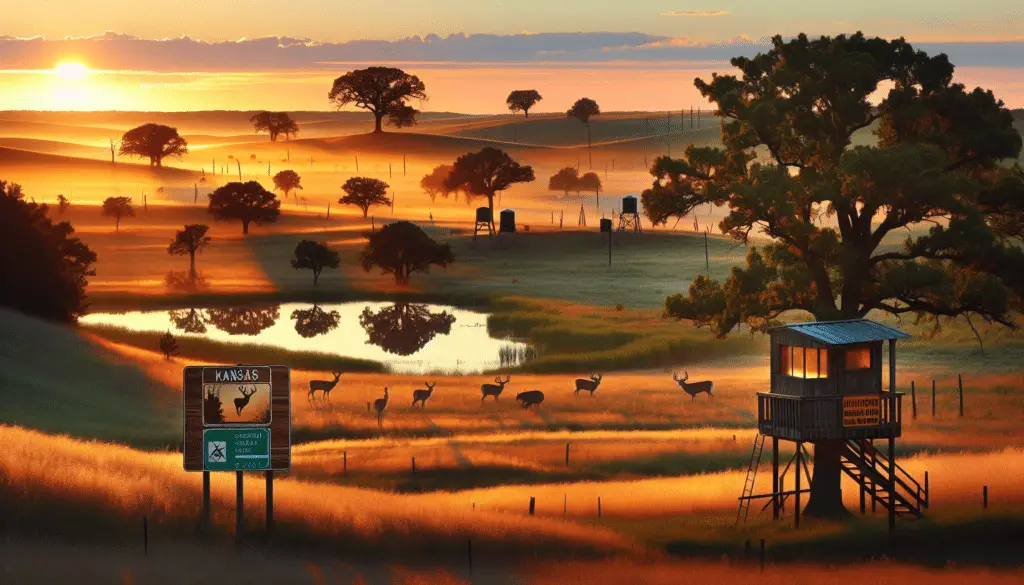Scouting and Selecting Prime Kansas Deer Hunting Locations
Table of Contents
ToggleWhen considering prime locations for deer hunting in Kansas, it’s crucial to scout and select areas that offer dense cover, reliable food sources, and access to water.
Public wildlife areas such as Tuttle Creek, along with Fort Riley, offer well-managed habitats that support thriving deer populations.
Additionally, the Walk-In Hunting Access (WIHA) program in Kansas provides hunters with opportunities across private lands that have been made accessible for public use.
By examining topographical maps and utilizing trail cameras, hunters can identify travel patterns and feeding areas.
Locating areas with fresh deer sign, such as tracks, rubs, and scrapes, can give insights into the daily routines of local deer, particularly the elusive bucks.
Understanding Deer Behavior for Effective Hunting Strategies
To maximize success in Kansas deer hunting, understanding deer behavior throughout the season is fundamental.
During the pre-rut and rut periods, bucks are more active and less cautious, providing ample opportunities for successful hunts during daylight hours.
Employing tactics such as rattling antlers and using doe estrus scents can be remarkably effective during the rut.
Conversely, post-rut bucks revert to more predictable patterns, focusing on food sources to recover from the breeding season.
Late-season hunting may require patience, as deer typically move less and are more likely to visit feeding sites during twilight times.
Understand that weather plays a significant role in deer activity; cold fronts can trigger increased deer movement.
Elevating Your Hunt with the Proper Equipment
Choosing the right equipment is a cornerstone of a successful Kansas deer hunt.
Selecting a reliable firearm or bow that you’re comfortable with will make a significant difference.
For firearms, the Winchester Model 70 is a popular choice among Kansas hunters due to its precision and reliability.
It’s a versatile rifle that offers a variety of calibers to suit different hunting scenarios in the diverse Kansas terrain.
With consistently positive reviews, this rifle’s accuracy and build quality make it a worthy investment for serious hunters.
When bowhunting, a compound bow like the Mathews V3 stands out for its compact design and silent mechanics.
This bow receives praise for its smooth draw cycle and formidable stopping power, essential qualities for close-range encounters with whitetails.
Find This and More on Amazon
Using Scents and Calls to Attract Kansas Whitetails
In Kansas’s vast landscapes, using deer scents and calls can tilt the odds in your favor.
Deer scents like Tink’s #69 Doe-in-Rut Buck Lure have garnered a following due to their effectiveness in mimicking the scent of a doe in estrus.
Such scents are particularly potent during the rut when bucks are eagerly seeking does.
On the auditory side, Primos Hunting calls have established themselves through reliable performance.
The Primos ‘The Original CAN’ Deer Call, with its ‘True Grip’ and versatile bleat sounds, is praised for its ease of use and ability to mimic doe and fawn communications, drawing in curious bucks.
It’s worth noting that local and migratory patterns, as well as individual buck idiosyncrasies, can affect the success rate of scent and auditory lures, but using these products can give hunters an edge in the field.
Camouflage and Concealment Tactics
Effective camouflage and concealment are vital when hunting the keen-eyed whitetail deer of Kansas.
It’s recommended to choose camouflage patterns that blend seamlessly with the local flora.
Mossy Oak and Realtree provide options that remain popular among hunters for their realistic patterns and seasonal versatility.
Ground blinds and tree stands, when used correctly, can remarkably enhance concealment.
A good quality tree stand, like those from Summit Treestands, can offer a secure and elevated vantage point, allowing you to remain out of a deer’s direct line of sight.
The Summit Viper SD Climbing Treestand is a standout for its portability and comfort during long hours in the field, and its full-perimeter frame is conducive for both rifle and bow hunting.
Focusing on Ethical Shot Placement
Regardless of the hunting method, ethical shot placement is a priority.
Shots should be taken only when the hunter is sure of a clean, humane kill, ideally targeting the vital organs—the heart and lungs.
Understanding where to shoot a deer to drop it in its tracks is critical knowledge every hunter must hold.
A well-placed shot not only ensures an ethical hunt but also reduces the likelihood of losing a wounded deer and maintains the quality of the meat.
Broadheads used in bowhunting must be sharp and well-maintained for quick, humane kills.
The Rage Hypodermic Crossbow Broadhead is a powerful tool renowned for its accuracy and wound channels, resulting in faster drops.
It’s highly regarded for its precision engineering and reliability in the field, based on hunters’ reviews.
Honing Your Skills: Practice Makes Perfect
A successful Kansas deer hunt isn’t all about being in the right place at the right time—it also hinges on skill.
Regular practice with your chosen firearm or bow is essential to build confidence and precision.
Many hunters recommend investing in a quality shooting target like the Rinehart 18-1 Archery Target for bowhunters seeking to perfect their aim.
Its durability and resistance to wear make it a staple for anyone serious about honing their archery skills.
For those using firearms, consistent visits to the shooting range and understanding ballistics are also key to accurate shooting.
Culinary Treats: Enhancing the Flavor of Your Venison
After a successful hunt, the next step is often preparing and enjoying the venison.
To remove the gamey taste that some find off-putting, proper field dressing, aging, and marinating the meat are crucial steps.
Using a marinade of vinegar, wine, or citrus can help in tenderizing the meat and neutralizing strong flavors.
Infusing venison with herbs or smoking it with fruit woods can also enhance the taste.
For ideas and tips on recipes and preparation methods, seasoned hunters and chefs alike share their expertise online, transforming that hard-earned catch into a gourmet experience.
Did you know? Many hunters believe that the diet of the deer greatly influences the taste of the meat, and Kansas deer, with their varied foraging habits, can produce exceptionally flavorful venison.
Seasonal Tactics for Kansas Deer Hunting Success
Seasonal changes in the Kansas landscape mean adjustments in hunting tactics are necessary for success.
Early season calling may not be as effective as later in the season during the rut when bucks are more receptive.
Food plots planted with clover, soybeans, or turnips can attract deer consistently before the rut arrives.
As the season transitions to the colder months, understanding how deer utilize thermal cover can give you an edge.
Deer, including whitetails, will often bed in areas that provide warmth from the winter chill and direct sunlight.
Ensuring you have the knowledge to find these bedding areas can lead to productive late-season hunts.
More than Just Whitetails: Kansas’ Other Deer Species
Kansas is not only home to the whitetail deer but also other species like the mule deer.
Each species has unique behaviors and preferred habitats which hunters must understand for a successful harvest.
While whitetail deer are more abundant and adaptable to varied environments, mule deer prefer the western prairies of Kansas.
Hunters should be prepared for longer shots and open terrain when targeting mule deer versus the often closer encounters in the forested areas common with whitetails.
Physical and Mental Preparation for the Hunt
Deer hunting can be physically demanding, especially in the unpredictable Kansas weather.
Physical fitness can play a crucial role in your ability to navigate the terrain and endure long hours of still hunting or tracking.
Mentally, it’s important to be patient and maintain focus, as deer hunting can often involve long periods of waiting with little action.
Being mentally prepared to make ethical decisions quickly when an opportunity presents itself is also paramount.
Navigating Kansas’ Hunting Regulations and Seasons
Staying informed about Kansas’ specific hunting regulations and seasons is crucial for a legal and ethical hunting experience.
Each hunting season has designated dates and regulations vary for archery, muzzleloader, and firearm seasons.
Hunters should check the Kansas Department of Wildlife, Parks, and Tourism’s website for the most up-to-date information.
Aside from season dates, there are also bag limits, tagging requirements, and restrictions on the transport and processing of game to consider.
Local Conservation Efforts and Their Impact on Hunting
Hunters play a significant role in conservation efforts, and Kansas is no exception.
Funds from hunting licenses and fees contribute to habitat improvements and wildlife management programs.
By participating in these conservation efforts, hunters not only ensure the sustainability of deer populations but also enrich the overall ecosystem.
Understanding and supporting local deer habitat conservation initiatives can result in more fruitful hunting seasons and ecological balance.
Joining the Kansas Hunting Community
Kansas has a robust hunting community that offers camaraderie, as well as shared knowledge and experiences.
Becoming involved in local hunting clubs or online forums can be a great way to gain insights and build relationships with fellow hunting enthusiasts.
Experienced hunters are often willing to share advice on locations, tactics, and safety, benefiting newcomers to the sport.
These communities also organize events and conservation activities, further contributing to the hunting heritage of the state.
Frequently Asked Questions
Where are the best places to go deer hunting in Kansas?
Public wildlife areas like Tuttle Creek and Fort Riley, along with private lands accessible through the WIHA program, provide some of the best deer hunting spots in Kansas.
When is the deer hunting season in Kansas?
The deer hunting season in Kansas typically starts in September with archery and extends through December or January, depending on the hunting method and zone.
Can non-residents apply for deer hunting permits in Kansas?
Yes, non-residents can apply for deer hunting permits in Kansas but should be aware of the limited number of permits available and the specific application deadlines.
What equipment do I need for deer hunting in Kansas?
Essential equipment includes a reliable firearm or bow, camouflage clothing, and depending on your strategy, items like tree stands, ground blinds, and deer scents and calls.
How can I learn more about deer hunting strategies and tips?
Joining the Kansas hunting community and participating in local hunting forums are excellent ways to learn more about deer hunting strategies and tips.


